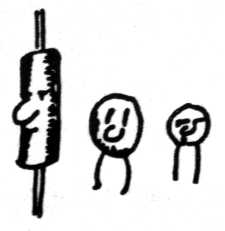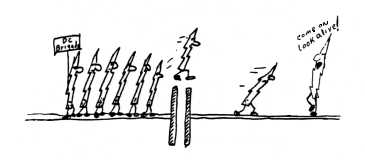
Capacitors are slightly more difficult to understand than resistors because there is no physical connection through them, though some types of current can still get through. But how can this be if there is no metal or other conductor? Before answering this question, let's first digress for a moment and consider the difference between alternating current (AC) and direct current (DC).
Direct current is the type of electricity you'd think of when using the water comparisons. That is, the current flows in only one direction. But with an alternating current, the direction is instead constantly changing. For the electrical circuits in your home, the direction alternates exactly sixty times per second. With audio (or radio) circuits, the range of frequencies is much greater.
Now let's see if we can find a suitable mechanical equivalent for a capacitor. How about a leaky bicycle pump? The type of pump I'm referring to consists of a plunger that is placed within a hollow metal tube. Now imagine that the plunger is not very well sealed, perhaps because it's a bit undersized. If you push the plunger very slowly, almost all of the air will leak back out. But if you increase the frequency of the pumping, less air will escape compared to the amount that travels the intended path. And if you give the pump a single fast push, some pressure will be developed though in a few moments it will dissipate.
In a similar manner, a capacitor allows electricity to flow, but only so long as the voltage is changing. Though there's no physical connection through it, a light bulb attached to a battery through a capacitor will flash briefly when they are first connected together.
The whole point of capacitors, therefore, is that
alternating currents can pass through them, while direct currents cannot.
Further, the higher the frequency or rate of change, the more current will be
able to get through. It's not hard to see how capacitors are valuable in the
design of the treble and bass controls on your stereo receiver.
Internally, a capacitor consists of two pieces of metal in close proximity, but not quite touching. If you can picture a piece of plastic food wrap sandwiched between two strips of aluminum foil, you're getting the general idea. A wire is attached to each strip of foil, and the whole thing is rolled up to save space and then dunked into goo that hardens. If you haven't done this, I recommend buying an assortment of resistors, capacitors, and other components at Radio Shack, just to bust them open and see what's inside. This is not only quite educational, but a lot of fun as well.
Besides allowing a circuit to pass only higher frequencies, capacitors are also useful for their storage capability. In fact, a capacitor is not unlike a rechargeable battery, since it can also hold a charge. But that's another issue we will discuss later. By the way, the larger a capacitor's metal surfaces are, or the closer they are together, the higher its capacitance will be.
The value of a capacitor is measured in Farads, though
you'll probably never see one that large. Similarly, you won't find a one Ohm
resistor very often either. When Messrs. Ohm and Faraday discovered these
properties long ago, they really had no concept of the way their components
would be used today.
Typically, capacitors are measured in microfarads, and just as often, picofarads (millionths and trillionths of a Farad respectively). Resistors of ten or one hundred Ohms are not that uncommon, but most of the ones in your PC are measured in Kilohms (1000 Ohms).